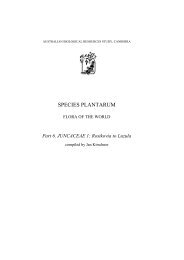Amborellaceae - Species Plantarum Programme
Amborellaceae - Species Plantarum Programme
Amborellaceae - Species Plantarum Programme
You also want an ePaper? Increase the reach of your titles
YUMPU automatically turns print PDFs into web optimized ePapers that Google loves.
INTRODUCTION<br />
<strong>Species</strong> <strong>Plantarum</strong> aims to provide in concise format, and with standardised data fields, basic<br />
taxonomic information on the vascular plants of the world, including accepted names and<br />
synonyms with bibliographic data, types of names, keys and descriptions from family to varietal<br />
levels, geographical distributions, ecological information and other related matters, and to publish<br />
it in both hard copy and electronic form.<br />
The format of the <strong>Species</strong> <strong>Plantarum</strong> is based on that of Flora of Australia, with some departures<br />
made necessary by the different scale of the project. Initially (vols. 1 to 11, and the introductory<br />
volume), the series was edited and published for the <strong>Species</strong> <strong>Plantarum</strong> Project and IOPI by the<br />
Australian Biological Resources Study (ABRS), producers of Flora of Australia. The editorial<br />
work is being continued by J. Kirschner (receiving editor, Institute of Botany, Academy of<br />
Sciences of the Czech Republic), C.E. Anderson (University of Michigan, Ann Arbor) and<br />
K. Marhold (Instute of Botany, Slovak Academy of Sciences).<br />
Treatments are contributed on a voluntary basis. Each part of <strong>Species</strong> <strong>Plantarum</strong> is intended to<br />
provide a complete account of a family, subfamily, large genus or other related taxonomic group.<br />
While treatments of small families may be shorter, it is intended that contributions will, in<br />
general, cover at least 50 to 100 species. Authors should contact the receiving editor before the<br />
preparation of their contributions.<br />
Distribution maps are based on those in R.K.Brummitt, World Geographical Scheme for Recording<br />
Plant Distributions 2nd edn (2001), and the ´countries´adopted are those of Level 3 and<br />
4 that work. Description of distribution follows the same work, with a two-digit code for regions<br />
and a three-letter code for the ´country´. Upper case letters for the ´country´indicate native<br />
distribution; lower case letters indicate that the taxon is only present in that ´country´ as an introduced<br />
and naturalised plant. If a taxon is extinct in a ´country´, this is indicated by a dagger.<br />
Distribution of species as cultivated plants is not included.<br />
Journal titles are abbreviated according to G.D.R. Bridson & E.R.Smith, Botanico-Periodicum-<br />
Huntianum/Suplementum (1991). Book titles are abbreviated according to F.A.Stafleu &<br />
R.S.Cowan, Taxonomic Literature (2nd edn) Vols 1-7, and Supplements (1976-), except that<br />
upper case initial letters are used for proper names and significant words. Authors of plant names<br />
are abbreviated according to R.K.Brummitt & C.E.Powell, Authors of Plant Names (1992).<br />
J. Kirschner<br />
Pru°honice<br />
December 2007<br />
vii












